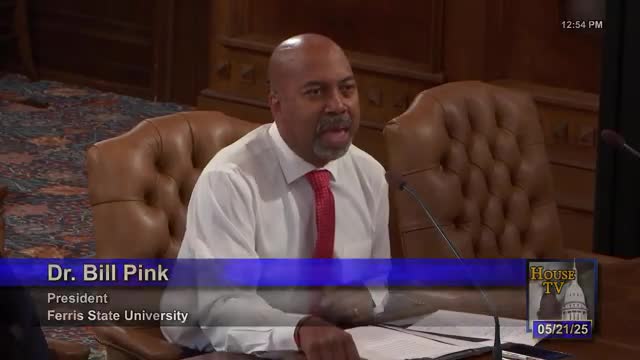Grand Valley State University outlines growth and economic impact amid enrollment challenges
May 21, 2025 | 2025 House Legislature MI, Michigan
This article was created by AI summarizing key points discussed. AI makes mistakes, so for full details and context, please refer to the video of the full meeting. Please report any errors so we can fix them. Report an error »

In a recent meeting of the Michigan Legislature's Appropriations Subcommittee on Higher Education and Community Colleges, significant discussions centered around the future of higher education funding and its implications for the state's economy. The meeting highlighted the critical role that public universities play in addressing Michigan's demographic challenges and workforce needs.
One of the key speakers emphasized the importance of state investment in higher education, framing it as essential not only for the universities themselves but also for the broader future of Michigan. The speaker, representing the faculty, staff, students, and alumni of a local university, expressed gratitude for legislative support and invited committee members to visit their campus, underscoring the connection between educational institutions and community engagement.
A notable point of discussion was the impact of federal grant funding on universities. A representative was asked to provide details on how much federal grant money had been affected, either frozen or clawed back, indicating ongoing concerns about financial stability in higher education. The representative assured the committee that they would provide specific numbers, highlighting the importance of transparency in funding matters.
The meeting also featured a presentation from Grand Valley State University (GVSU), which has seen significant growth despite broader trends of declining enrollment in Michigan. GVSU's president noted that the university has grown by 5% in overall enrollment over the past two decades, contrasting with a 24% decline in regional public university populations. This growth is particularly noteworthy given Michigan's ranking as one of the lowest states in population growth over the last 20 years.
The president pointed out that Michigan has lost a substantial percentage of high school graduates, which poses a challenge for universities aiming to produce a skilled workforce. He stressed the need for higher education institutions to adapt and focus on fields that align with the state's economic needs, such as advanced manufacturing and technology.
The discussions at this meeting reflect a broader concern about the sustainability of higher education funding in Michigan and the need for strategic investments to ensure that universities can continue to serve as engines of economic development. As the state grapples with demographic shifts and workforce challenges, the outcomes of these discussions will be crucial in shaping the future of higher education and its role in Michigan's economy. The committee's next steps will likely involve further examination of funding strategies and their alignment with the state's educational and economic goals.
One of the key speakers emphasized the importance of state investment in higher education, framing it as essential not only for the universities themselves but also for the broader future of Michigan. The speaker, representing the faculty, staff, students, and alumni of a local university, expressed gratitude for legislative support and invited committee members to visit their campus, underscoring the connection between educational institutions and community engagement.
A notable point of discussion was the impact of federal grant funding on universities. A representative was asked to provide details on how much federal grant money had been affected, either frozen or clawed back, indicating ongoing concerns about financial stability in higher education. The representative assured the committee that they would provide specific numbers, highlighting the importance of transparency in funding matters.
The meeting also featured a presentation from Grand Valley State University (GVSU), which has seen significant growth despite broader trends of declining enrollment in Michigan. GVSU's president noted that the university has grown by 5% in overall enrollment over the past two decades, contrasting with a 24% decline in regional public university populations. This growth is particularly noteworthy given Michigan's ranking as one of the lowest states in population growth over the last 20 years.
The president pointed out that Michigan has lost a substantial percentage of high school graduates, which poses a challenge for universities aiming to produce a skilled workforce. He stressed the need for higher education institutions to adapt and focus on fields that align with the state's economic needs, such as advanced manufacturing and technology.
The discussions at this meeting reflect a broader concern about the sustainability of higher education funding in Michigan and the need for strategic investments to ensure that universities can continue to serve as engines of economic development. As the state grapples with demographic shifts and workforce challenges, the outcomes of these discussions will be crucial in shaping the future of higher education and its role in Michigan's economy. The committee's next steps will likely involve further examination of funding strategies and their alignment with the state's educational and economic goals.
View full meeting
This article is based on a recent meeting—watch the full video and explore the complete transcript for deeper insights into the discussion.
View full meeting
